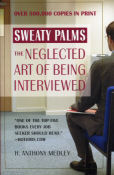| What REALLY goes on in a job interview? Find out in the new revision of "Sweaty Palms: The Neglected Art of Being Interviewed" (Warner Books) by Tony Medley, updated for the world of the Internet . Over 500,000 copies in print and the only book on the job interview written by an experienced interviewer, one who has conducted thousands of interviews. This is the truth, not the ivory tower speculations of those who write but have no actual experience. "One of the top five books every job seeker should read," says Hotjobs.com. | |
| The Wind That Shakes the Barley (10/10) by Tony Medley This is a brilliant, compelling telling of the Irish fight for independence from Britain. The format of the telling reminded me a lot of the Kirk Douglas-Burt Lancaster film “The Devil’s Disciple” (1959) based on George Bernard Shaw’s play of the same name, although there is nothing comedic about this. In order to enjoy the film and get the most out of it, however, it is necessary to know something about Irish history. The English invaded Ireland in the 12th Century and established penal laws that kept the Irish in subservience until the early 20th Century, when the Fenian Brotherhood, started in the 19th Century, could no longer be denied. In 1916 the Irish Citizen Army staged a doomed but symbolically powerful armed uprising in Dublin, which was put down brutally by the British. After they executed the leaders, the harsh military reprisals that followed swayed public support away from moderate nationalism to the separatist movement, embodied in the Sinn Féin (“We Ourselves”) political party and Irish volunteers. This resulted in the 1918 election in which Senn Féin won a huge majority throughout the country, except in the northeast, where Protestant Unionists, who were opposed to any change in the Union with Britain, held the day. That small segment of Ireland is still the problem today, as the Protestants have steadfastly discriminated against Catholics. To give President Clinton credit, he is the only U.S. President of my memory who did anything to try to solve the problem of the Protestant persecution of the Catholic minority in Northern Ireland. When his eight-year term ended, and the Bushes once again regained the White House, U.S. interest in the Irish problem ended. After the 1918 election, Sinn Féin established an Irish parliament, Dáil Eireann, and declared Irish independence to the world. Unfortunately, nobody in the international community would give it credence and the British government refused to accept it. The Dáli was outlawed, the Republic went underground and the Irish Volunteers became the Irish Republican Army (IRA). Even though underground, a counter-state was developed, including courts, and it was supported by the labor movement. The rail workers refused to transport anything or anybody British, and the IRA took the offensive against the armed police force, the Royal Irish Constabulary (RIC). The British reinforced the RIC with hoodlums called the “Black and Tans,” mostly demobilized First World War soldiers, and the Auxiliaries, a corps of former officers. The British were brutal, raiding, burning, and looting houses, villages, and towns, all of which is depicted in this film. The IRA retaliated by countryside ambushes. The Irish were hopelessly outgunned. At no time were there more than 3,500 guns and rifles in their hands, against the enormously well-armed British. This film shows what a heartless, brutal civil war it was. Finally, the Anglo-Irish Treaty was signed in December of 1921, which ended the violence but dashed the hopes of many who wanted complete freedom, the result of which set brother against brother. Based on this background, this is the setting about which Director Ken Loach and writer Paul Laverty have made a brilliant film that shows what it was like, circa 1920-22. Damien (Cillian Murphy) is a young doctor who is about to leave for England. Teddy (Pádraic Delaney) is his brother who is committed to obtaining Irish freedom. Two brutal incidents convince Damien his place is to remain in Ireland as a patriot. As things progress, however, after the treaty, Damien and Teddy end up on opposite sides, and not the sides one would have predicted at the outset. This is an action-packed, psychologically violent film that zeroes in on what it’s like to be an oppressed majority, and how a Civil War can rip families apart. Murphy and Delaney give exceptional performances, which add to the tension of this movie that runs four minutes over two hours. Murphy, a deliciously evil bad guy in 2005 in both “Batman Begins” and “Red Eye,” shows that he is an actor with admirable range here, as a protagonist. I didn’t look at my watch once. The only problem I had with it was that the realistic, heavy Irish brogues were often difficult to comprehend. But that’s a minor complaint for such a wonderful, educational film that captures history. In theatres and video on demand to cable subscribers on IFC In Theatres. March 11, 2007
|
|
|
|
|
